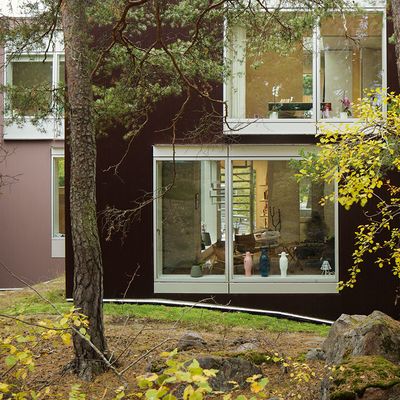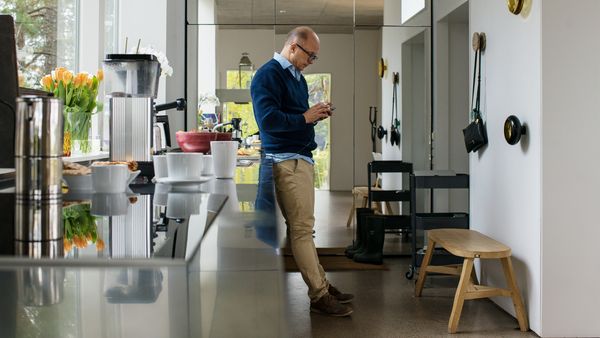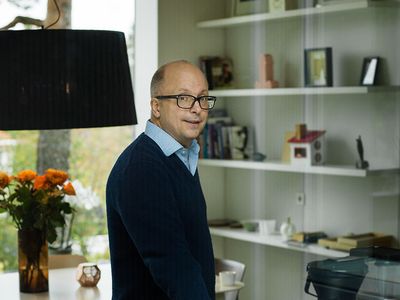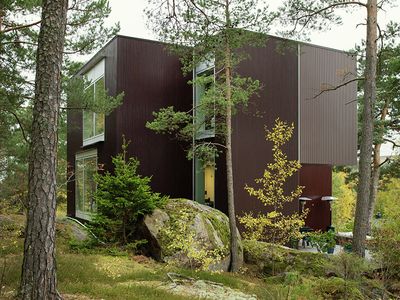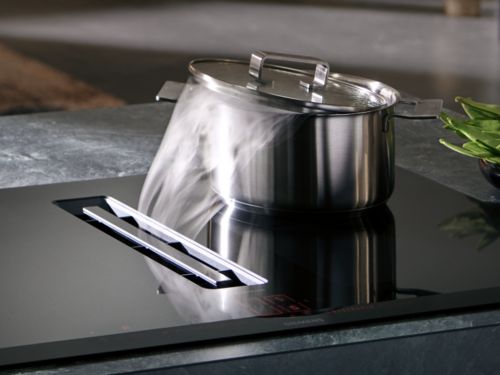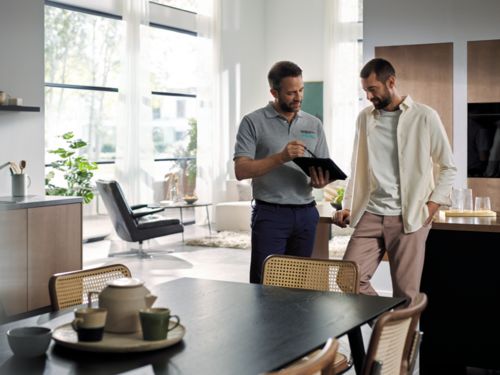Allan Spiegel – Interior Consultant, Villa Altona, Sollentuna (Sweden)
Allan Spiegel won’t give you the answers of an architect, neither will he recite any industry buzz words. But he will tell you about his love for production processes, the influences of his interior design heroes, and how light and open rooms can invite people to the heart of any home – namely the kitchen.
Allan is a self taught interior consultant who works with some of the biggest retail brands, restaurants and hotels in Sweden. In 2011, a midday internet browsing session resulted in him investing in a unique piece of land in the suburb of Sollentuna, Sweden. A leap of faith that led the interior consultant into the world of architecture and construction work, but on his terms.
Shaped by the last Ice Age, the plot features unique topographical characteristics on which Allan, alongside an architecture duo and two workers decided to create his family home, “Villa Altona.” A house that refuses to override nature’s boundaries, but rather becomes one with its surroundings.
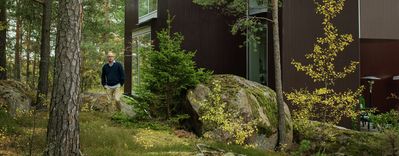
"I chose this plot because it’s close to both worlds and because Sollentuna is a nice county to live in. I do prefer both environments, but I’m actually more fond of the city rather than the suburban areas."
"People will keep on saying, ‘you can never do that,’ but I did. I succeeded. The main thing is that if you are a handy person, you can learn everything you want during the process, from the internet or other people."
First off, what does the name Villa Altona mean?
Altona is a part in Hamburg where my family comes from. And it’s also the name of my company. The idea from the beginning was to make Altona 1 and then build more houses, Altona 2 and 3 and so on. There are no concrete plans of fulflling that vision just yet, but there are probably going to be more houses.
As an interior consultant, mostly working with furniture, what created the spark to build a whole house?
If you’re a cabinet maker you can build a house. You can always learn more, most things are possible. People will keep on saying, ‘you can never do that,’ but I did. I succeeded. The main thing is that if you are a handy person, you can learn everything you want during the process, from the internet or other people.
Would you have built this house if it weren’t for the way this particular plot appealed to you?
No, not this house. This house is very specifc for this type of terrain. It follows the topographic landscape and the terrain and divides the house into four levels that follow the nature. The ground is divided into four sections where the walls and shape of the house are adjusted to the terrain. Normally in Sweden, you would use dynamite to even the surface, but I don’t like that. I wanted to build around the terrain instead.
It took you one and a half year to build this house from the ground up. You were never more than two people working on the house at the same time. How did you know when you were done? Did it feel like home?
I felt at home immediately. We moved in while we were still working with the project. In the beginning, there were no doors to the bathrooms, we had drapes. The stairs were not here, so we used ladders. For me, I can’t name a date when we moved in, I don’t even know when that would be. I felt at home from the beginning.
The villa is situated in an urban environment among buildings of different infuences. It’s almost like you’re living in an oasis where the city meets the woods. Do you prefer the city over the countryside, or the other way around?
I chose this plot because it’s close to both worlds and because Sollentuna is a nice county to live in. I do prefer both environments, but I’m actually more fond of the city rather than the suburban areas. We ended up in Sollentuna because of the children and the schools. If it was up to me, and only me living on my own, I would choose to either be in the city or to be around even more nature.
"If you go to a party, everyone’s in the kitchen. It’s always like that."
Your work revolves around hotels and restaurants – spaces that are naturally social. How is this transferred to your home?
Normally, if you look at a drawing of an apartment or house, the living room is always bigger than the kitchen and you usually have a dining area that is never used. But when you go to visit someone, you always stay in the kitchen. If you go to a party, everyone’s in the kitchen. It’s always like that. The living room doesn't need the same space, really. That’s a room you usually use when you’re alone or with your family. The kitchen is the place where we meet.
Did you consciously go into working with restaurant interiors?
I just ended up working in these environments, but I think a major correlation is that the people who like food and work with food talk the same language. I also like cooking, so we are the same kind of people and we get along.
Where does your interest in food come from?
In my family we have always enjoyed cooking. My mother owned a restaurant, and I did too for a while. I worked part-time in restaurants when I was younger. And my grandmother would spend all her days cooking. Right after breakfast, seriously, she would start cooking for dinner. I think that’s why I understand taste and how to put things together.
How would you describe that type of person?
Most of them are funny, and they have a temper. They enjoy drinking and eating, they’re social beings and mostly nice people. Not too pretentious.
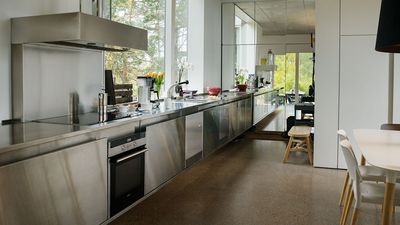
"I prefer Spanish and German design."
There is a characteristic Scandinavian style in design. Your house and furniture feels light and open, not entirely characteristic of this area. How would you describe your infuences?
I like Scandinavian furniture, but If I were to mention what I like for living spaces, I prefer Spanish companies and designers. I think they are easier and more poetic than others. In terms of furniture for offces, I prefer the German style. It comes down to function. The typical Danish retro style is something that is very nice and popular, and I use it a lot in my work with restaurants, but I prefer Spanish and German design.
You are self taught and have never been employed in a traditional agency setting. In what way do you think your process, and ultimately style, differs from that of other people who have been working as employees at offices?
I never make drawings on the computer, for example. I always make some hand drawings for myself and then go straight to the prototyping stage. I always work in full size scale. Others work with 3D drawings, but I fnd that less fun. With a direct prototype, you can directly see ‘Oh this is too high, or too low,’ and I am convinced this is a much quicker process. Otherwise, you spend time on making a 3D model, which might look really nice in that stage, but ends up looking strange in real life, or the other way around.
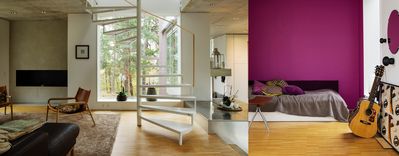
"If you take a chair for example, it`s main thing is to be functional. You really have to start with making it comfortable. It also has to be durable. You are a very good furniture maker if you can combine this."
It sounds like you prefer a more manual approach to your work. What role does technology play in your life?
I think technology is really good if you look towards machines and production in furniture design. But yes, I like doing things in a more manual way, to be honest. I like putting a vinyl record on. I like analog processes. I’m very old fashioned in that way. The only technology I use is when I cook; my stove, the washing machine, kitchen gadgets. That and I listen to Spotify.
What are some other infuences in your life and work?
I’m quite boring in that way. I like nature and I like factories. I like the production, and really enjoy going to factories. Whenever I go to a new client or manufacturer, I always ask them to show me the facilities. I’m like a kid really. If there is a machine I haven’t seen before, I can ask them if I can work with them a full day in order to see how it all comes together. I think that’s a lot of fun.
Do you go for function or beauty?
I go for function.
Why is that?
Because you are living in function. Of course there should be nice and beautiful environments, but if you only live in beauty, it’s impossible to have a normal life. Then you have to arrange everything and put it into place all the time.
Do you have the same approach to interiors?
Yes, but I would say that function is also beauty. If you take a chair for example, it’s main thing is to be functional. You really have to start with making it comfortable. It also has to be durable. You are a very good furniture maker if you can combine this. There are so many chairs that look good but are not nice to sit in, but the only reason for a chair to exist is that it’s nice to sit in.
What is ugly to you?
If you go to buildings and furniture, I think you need to be honest and not only look towards the trend that is going on at the moment. If you look at a restaurant, it’s always a stage. For more long-term projects, especially in furniture, there needs to be more long-term thinking too. The furniture I work with is very expensive, so if I buy it then I want it to last for many years. Everything needs a meaning, and I think that’s important.
How does this thinking apply to houses?
The same applies to houses. If you have a house from the 1920s, the best thing is to keep the structure of that style altogether. Not to turn different rooms into different eras, but to keep it consistent with the time it was built. When it comes to the furniture you’re putting in there, you can experiment a bit more with different times. There are no ugly times.
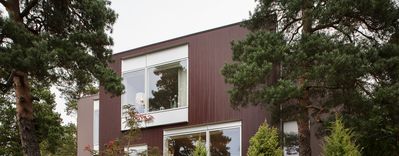
Thank you Allan for showing us your unique home and letting us explore your professional journey.
Have a look at Villa Altona and Allan's interior consultancy.
Find out more
